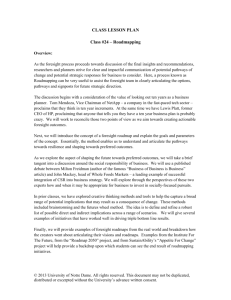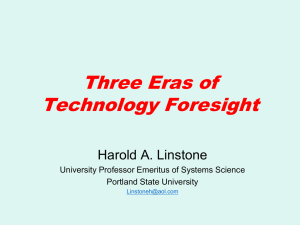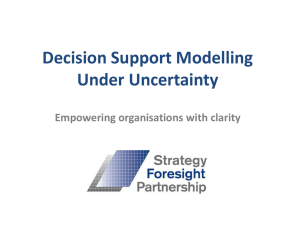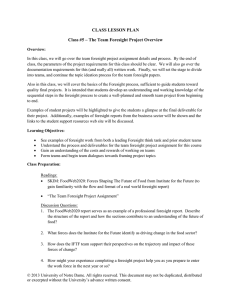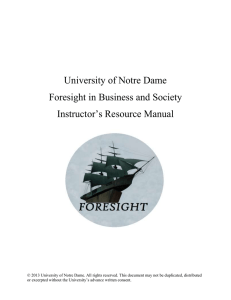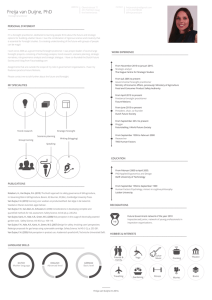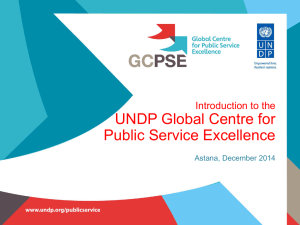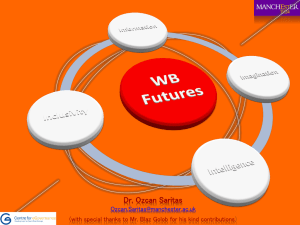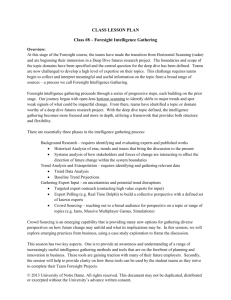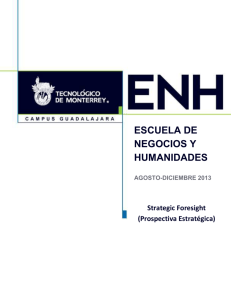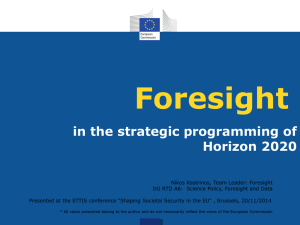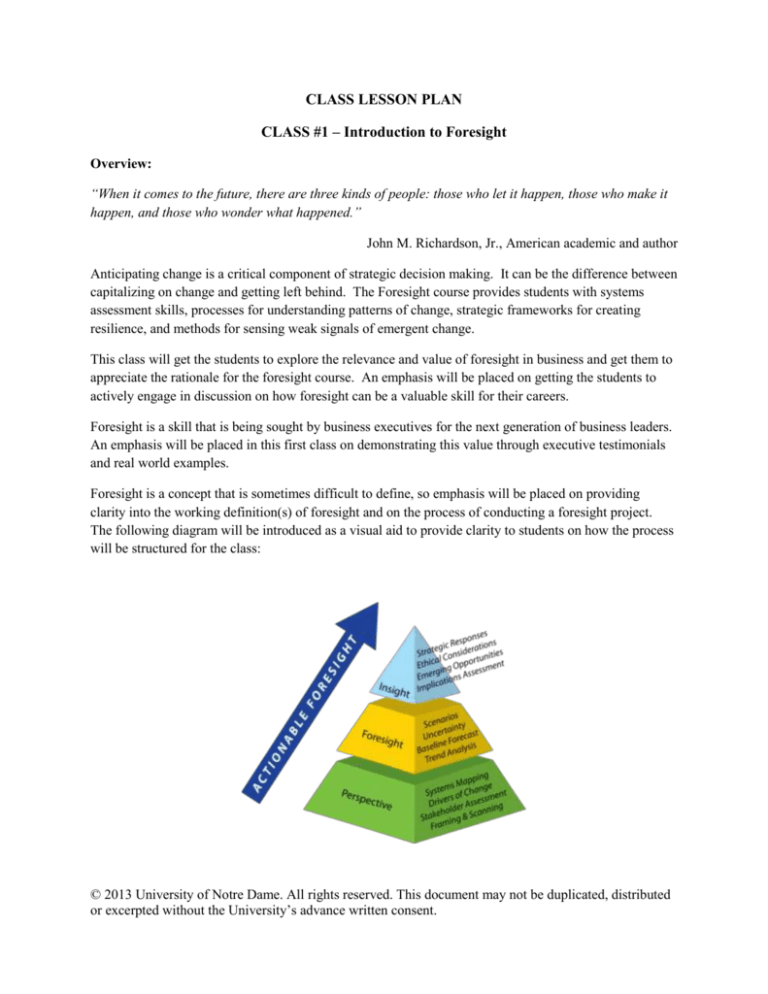
CLASS LESSON PLAN
CLASS #1 – Introduction to Foresight
Overview:
“When it comes to the future, there are three kinds of people: those who let it happen, those who make it
happen, and those who wonder what happened.”
John M. Richardson, Jr., American academic and author
Anticipating change is a critical component of strategic decision making. It can be the difference between
capitalizing on change and getting left behind. The Foresight course provides students with systems
assessment skills, processes for understanding patterns of change, strategic frameworks for creating
resilience, and methods for sensing weak signals of emergent change.
This class will get the students to explore the relevance and value of foresight in business and get them to
appreciate the rationale for the foresight course. An emphasis will be placed on getting the students to
actively engage in discussion on how foresight can be a valuable skill for their careers.
Foresight is a skill that is being sought by business executives for the next generation of business leaders.
An emphasis will be placed in this first class on demonstrating this value through executive testimonials
and real world examples.
Foresight is a concept that is sometimes difficult to define, so emphasis will be placed on providing
clarity into the working definition(s) of foresight and on the process of conducting a foresight project.
The following diagram will be introduced as a visual aid to provide clarity to students on how the process
will be structured for the class:
© 2013 University of Notre Dame. All rights reserved. This document may not be duplicated, distributed
or excerpted without the University’s advance written consent.
Class Learning Objectives:
Gain an understanding of the meaning of foresight in business
Explore and discuss the relevance and value of foresight in business
Become acquainted with the professor and peers
Review the syllabus, semester schedule and project timetable
Key Terms and Concepts:
(Actionable) Foresight
Future Studies
Obsolescence
Strategy and Strategic Positioning
Operational Excellence
Competitive Advantage
Strategic Advantage
Class Preparation:
No Pre-Reads
Class Syllabus will be distributed in class
© 2013 University of Notre Dame. All rights reserved. This document may not be duplicated, distributed
or excerpted without the University’s advance written consent.
INSTRUCTOR GUIDELINES
Discussion Launchers:
We will use several participative exercises to lead the students to see the value of foresight skills and
embrace the objectives of the course. These include:
1. Consider… “Why do market leaders so often get caught off guard?”
a. Show examples including:
i. KODAK not seeing a filmless future
ii. HP not foreseeing the tablet transition
iii. GM not foreseeing the market for hybrids
iv. Microsoft not foreseeing the market value of Search
b. Engage the students to explore how these companies, with better resources, talent and
market access than the rest, did not foresee what in hindsight was a game changing
opportunity or risk.
2. After watching “The Future Is…” video, get the students to discuss.
a. Was there anything they learned in the video that was surprising?
b. What are the skills they will need to succeed in their careers?
3. To illustrate transformative change, we will split the groups into triads, give them index cards and
ask them to brainstorm on three questions:
a. What technologies did not exist 10 years ago that are now mainstream?
b. What technologies were mainstream 10 years ago that are now obsolete?
c. What technologies are mainstream today that might be obsolete in 10 years?
4. To link foresight to practical business, use the Michael Porter definition of strategy (which
differentiates being better from being different). See Porter, M. (1996). What is Strategy?.
Harvard Business Review, 61-78. Present the basic premise which is that operational excellence
(being better, which is not strategy) usually crowds out being different (which is strategy) and
companies then react via straddling or repositioning, which is usually ineffective. Use this
definition as a platform to discuss the value of foresight in business.
a. What are examples of business of CEO’s that have created strategic advantage by being
different? (Southwest Airlines, Cirque du Soleil, Apple, Pixar, Keurig, IKEA, Amazon,
Dell, Netflix, others)
© 2013 University of Notre Dame. All rights reserved. This document may not be duplicated, distributed
or excerpted without the University’s advance written consent.
b. What are examples of companies that may have stayed the same too long? (GM,
Blockbuster, AOL, R.I.M. LA Times, Sony, Circuit City)
c. Why companies would hesitate to pursue a strategy of being different? (The growth trap
– small incremental growth is safer and seductive uncertainty about future scenarios leads
risk averse businesses to focus on making incremental improvements that are safer and
more predictable.)
d. What types of processes and planning methods would enable companies to reduce the
risk of being different? Foresight methods that help bring evidence into the decision
process, provide structure to a range of nebulous plausible scenarios, and enable business
to identify weak signals from the ever-more-noisy information sources they monitor.
Class Timeline:
15 minutes: Discussion Launcher: “Why do market leaders so often get caught off guard?
15 minutes: Transition to the “The Future Is…” video
o Ask Students what they learned from the video that was surprising – discussion leading to
how students think foresight could be of value to their careers
15 minutes: Triad discussion on obsolescence [3 levels] with report out
10 minutes: What is Strategy discussion
o Discuss the concept and explore examples of companies that have gained advantage from
being different and companies that hung on to operational excellence for too long
15 minutes: Intro to Course Intro w/ Student Questions
o Intro of Professor & Office Hours
o Objectives of Course
o Overview of Syllabus
Learning Modules
Research Paper & Team Component (Deep Dive)
Grading
5 minutes: Quick Look forward to next class – Graph, Paragraph, Photograph assignment
Classroom Activities/Short Assignments:
Obsolescence triad w index cards. Pass out index cards and have students assemble into
triads/groups of three. Ask them to discuss and write down answers to the following three
questions (as shown on the slides):
1. What is obsolete now that was mainstream 10 years ago?
2. What is mainstream now that did not exist 10 years ago?
© 2013 University of Notre Dame. All rights reserved. This document may not be duplicated, distributed
or excerpted without the University’s advance written consent.
3. What is mainstream today that may be obsolete in 10 years?
After students consider all three questions, have students call out answers for discussion.
Multimedia Supplements:
“The Future Is…” Video – Created by the Mendoza College of Business to set the stage for the
course, facilitate students’ thinking about the future, and provide an avenue for corporate
executives to share with students the value of foresight skills. Available upon request.
Notes and Perspectives:
As additional prep, instructors are encouraged to read “What is Strategy” (M. Porter) and “Blue Ocean
Strategy” (Kim & Mauborgne) – both from HBR
© 2013 University of Notre Dame. All rights reserved. This document may not be duplicated, distributed
or excerpted without the University’s advance written consent.

